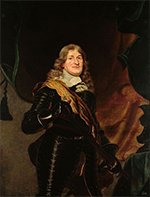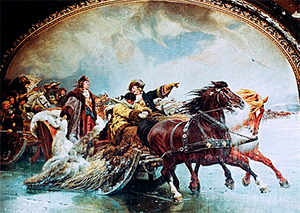Frederick William: Duke of Prussia
Frederick William was Elector of Brandenburg and Duke of Prussia in the 17th Century. A powerful personality, he ruled for nearly five decades, leaving his stamp on much of Europe. 
He was born on Feb. 16, 1620, in Stadtschloss. His father was the reigning Duke of Prussia and Elector of Brandenburg, George William, and his mother was Elisabeth Charlotte of the Palatinate. The boy was his parents' only son and so was expected to follow in his father's political footsteps. Young Frederick William grew up in the shadow of the Thirty Years War, which raged for his entire growing up years, ending in 1648 with the Peace of Westphalia. He succeeded his father as head of Brandenburg and Prussia on Dec. 1, 1640, while the war was still going. Having watched northern Germany be devastated by warfare, he vowed to build up his state's army. He did so, creating a model for the vaunted Prussian Army of future years. Frederick William married Louis Henriette of Nassau in 1646. They had six children, three of whom survived into adulthood: Charles (1655), Frederick (1657), and Louis (1666). Luise died in 1667. The duke got married again the following year, to Sophie Dorothea of Holstein-Sonderburg-Glücksburg. They had seven children, six of whom survived into adulthood: Philip William (1669), Marie Amelie (1670), Albert Frederick (1672), Charles Philip (1673), Elisabeth Sofie (1674), and Christian Ludwig (1677). Prussian troops flexed their muscles in the Second Northern War, which ended with Prussia's throwing off the yoke of Sweden, which had controlled the duchy for several years. Frederick William intervened in the Franco-Dutch War in the 1670s, first on one side and then the other. In 1675, he led his troops on a forced march of 155 miles in two weeks in order to confront a Swedish force that had invaded Brandenburg. The resulting Battle of Fehrbellin was a resounding Prussian victory. 
Frederick William cemented his reputation as a successful military commander in 1679 with the Great Sleigh Drive. This was a bold pursuit of retreating Swedish troops, during which he ordered the commandeering of a large number of sleighs to use to transport his troops across the frozen lands and lakes between him and the enemy. The rampaging Prussians struck the retreating Swedish hard, resulting in many casualties and the end of the Scanian War. On the home front, Frederick William put great effort into rebuilding his wartorn land. He encouraged mercantilism and the growth of big business. He ordered the construction of a national water travel system by connecting rivers with canals. Perhaps the most well-known of those is now named after him, linking Berlin to commerce from the ocean. He also knew an opportunity for immigration when he saw one. The French King Henry IV had in 1598 issued the Edict of Nantes, a declaration of religious tolerance that protected the large population of Protestant Huguenots who lived in France. In 1685, France's Louis XIV revoked the Edict of Nantes; as a result, many Huguenots avoided persecution by fleeing France. Frederick William responded with the Edict of Potsdam, which encouraged Huguenots to emigrate to Brandenburg Prussia. The result was a large increase in skilled labor, as tens of thousands of people arrived to swell the Prussian ranks. Frederick William became known as the Great Elector. His power and his reputation were both wide-raging. When he died, on April 29, 1688, in Stadtschloss, he left his lands in good stead. His son Frederick then took the reins. |
|
Social Studies for Kids
copyright 2002–2026
David White




